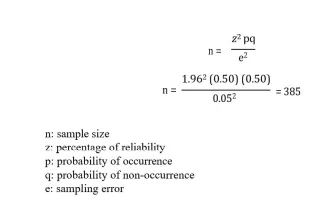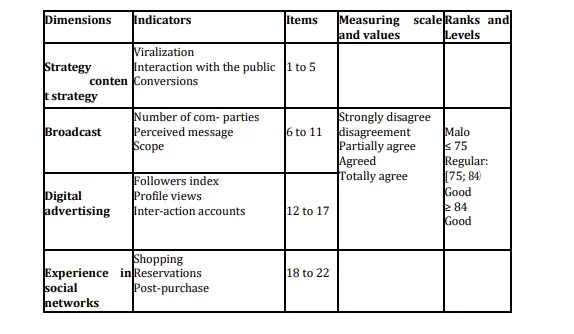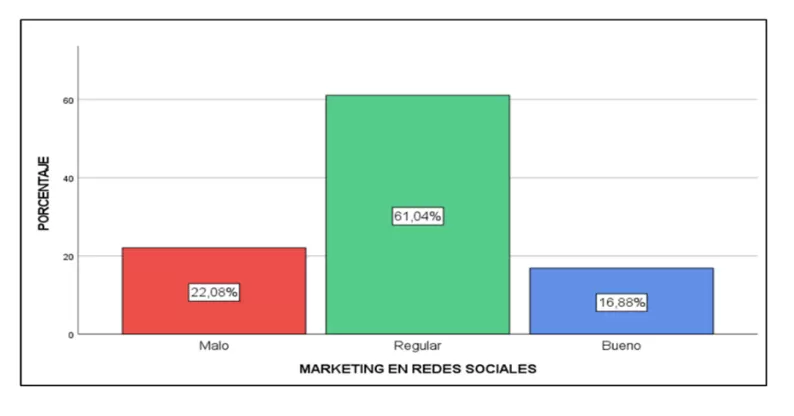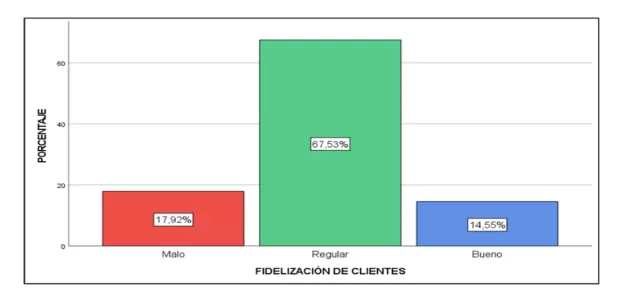Introduction
In an environment where competitiveness has been increasing, technology has advanced significantly and the demands generated by the COVID-19 pandemic have been remarkable, it is crucial to access new market segments using various strategies through popular social networks such as Instagram, Facebook, TikTok, and YouTube (Statista.com, 2021; Ponce, 2021).
Due to globalization, companies are managing more information faster, so they are forced to become more competitive, i.e., to have the ability to manage their information more efficiently, the ability to develop in a highly competitive and increasingly demanding market (Suárez and Pérez, 2021; Lluís, 2010).
Marketing encompasses everything from the study of the market to detect the needs of consumers or users to the satisfaction of those needs with the launching of new services, products, or improvements in these through the common cation of these novelties and the study to establish their prices; the strategy to build loyalty among internal (staff) and external customers; the analysis of consumer or user behavior; and after-sales service (Cibrián, 2018, Sainz, 2018).
The term marketing is regularly associated or confused with different meanings; some organizations relate it exclusively to sales, others to advertising or market research; for some, it is an aggressive marketing approach, and, for others, it is a promotional orientation toward the consumer (Coca, 2008; Olivier, 2020).
In recent years, social media marketing has gained considerable importance for companies, as they see it as an effective tool to increase the sales of their products. This is due to technological advances and the fact that most people own a smartphone and use social networks. This reality allows for reaching new customers and promotes the consumption of their products (Sicilia et al., 2021; Hubspot, 2022).
Today, there are endless definitions of digital marketing, although all are related; you can find that digital marketing is also recognized as interactive, focused, measurable marketing, which is performed using digital technologies to reach and create customer prospects in consumers. The main objective of digital marketing is to promote brands, create preference, and increase sales, all through different digital marketing techniques, even though this concept does not remain static, since the practice of this discipline evolves constantly and deeply, leading to changes in recent years in the tools and platforms of digital marketing (Galeano, 2019; Perdigón et al., 2018).
According to a 2022 study, in Latin America, companies plan to allocate 60% of their budget to marketing, to increase this proportion to 85% in the future. In addition, it has been observed that 90% of the companies in the region already have a clearly defined marketing strategy. TikTok is becoming more relevant compared to Facebook and is essential for maintaining a good relationship with customers. Globally, investment in social media marketing shows a 37% difference compared to Latin America (Madurga, 2022; Gestión, 2022).
In Peru, a 2022 report indicated that business investment in advertising and market research grew to 15.78%, in contrast to the 6.03% recorded in 2019. This increase is attributed to the success and reach of digital, traditional, and merchandising marketing, among others. Peruvian companies have started to increase their investments in digital marketing, a previously uncommon practice, driven by the pandemic that accelerated the digital era. With greater investments, companies can attract new customers and improve their profitability (INEI, 2022; El Peruano, 2022).
Managing loyalty to the level of planning it into a program is a tool that offers incentives and recognizes the most profitable customers by maintaining their loyalty and increasing sales (Peña et al., 2015; RD Station, 2017).
The analysis carried out in this research work formulates the following problem: What is the relationship between social media marketing and customer loyalty in a restaurant in Cieneguilla, Peru?
Several studies affirm that the variables described in this study are correlational.
A study by Eruditus magazine analyzed relationship marketing as a strategy for customer loyalty on social networks. The research, which was quantitative and cross-sectional, involved a sample of 250 clients between 15 and 54 years of age. It concluded that this strategy is essential to strengthen ties and achieve positive results through constant communication on platforms such as Facebook, Instagram, and WhatsApp. The study highlights the importance of valuing customers, as their proper attention through social networks improves relationships and contributes to business success (Miranda et al., 2022).
A study in a travel agency examined the relationship between social media marketing and customer loyalty. A significant positive correlation (r=0.534) was found with a sample of 142 customers. In addition, the importance of interactivity, personalization, and information in customer loyalty was highlighted, as well as the importance of word of mouth in the company’s recommendations (Basaldua and Quispe, 2021). Social media marketing is perceived in different ways; however, these perspectives tend to complement each other. In general, it refers to the strategies applied through social network platforms, such as the creation of value for customers and the interaction between customer and company on these platforms (Benedetti, 2020; Masía and Santoja, 2017).
Similarly, it is important to highlight the theories directly associated with the marketing variable in social networks such as community management, engagement, social media, and influencer marketing (Alcaide, 2015; Cestau, 2020; García and Gutierrez, 2013).
Customer loyalty implies that customers repeatedly choose a company for their purchases. To achieve this, the company must identify customer needs, create value, and establish effective communication to differentiate itself and strengthen the customer-company relationship (García and Gutiérrez, 2013; Altamirano, 2021).
Similarly, it is important to highlight the strategies directly associated with the customer loyalty variable, such as having customer information, developing internal marketing, establishing good communication with the customer, customer experience, and customer incentives and privileges (Cestau, 2020; Nieto, 2021).
Given the above, there is a need to develop research on social media marketing, since it is important to enhance all possible fronts of effective communication (Comex, 2022).
Social media marketing uses only the new technological and digital media and advertising channels, and thanks to this, it allows the creation of better products and services in a personalized way, measuring the different actions to obtain a continuous improvement. In other words, it is a set of digital tools that enable the empowerment of a brand (Fuente, 2020; Mejía and Martín, 2020).
Finally, about the literature review, it can be determined that the scientific basis on which the relationship between the study variables is found is the psychological one since it has to do with the thoughts, emotions, and feelings that generate certain loyalty strategies in customers, which can be directed and communicated more strategically through social media marketing; that is why it is important to correctly apply the established strategies to be accepted by customers (Ycaza, 2021; Pinargote, 2019).
Materials and Methods
The present study has a quantitative approach because data collection was performed to analyze and enter into the statistical program to obtain results; it is of a basic type because it was based on theories to support the study and reach the resolution of the research problem and it is of a correlational level because its purpose is to support the relationship that exists between the study variables (Ñaupas et al., 2018; Pérez and Moya, 2023).
In the case of the research, the population is taken as customers in a restaurant in Cieneguilla, Peru, and it is considered an infinite population since there is no database or registry of both male and female customers. The inclusion criteria considered are the customers of the period 2023 and customers who know the company and have made business transactions through social networks.
The research uses non-probabilistic convenience sampling because it focuses on applying the questionnaires to people who have been to the restaurant more than once and who know the company through social networks (Baena, 2017).
This type of sampling involves the researcher’s criteria to select the sample units, according to certain characteristics required by the nature of the research to be carried out (Martínez, 2019).
Since the research has an infinite population due to the lack of a customer registry, a sample of 385 customers of the company that meet the inclusion criteria is required.
The formula is as follows:

Table 1. Operationalization table of the variable marketing in social networks

Considering that the social media marketing variable shown in Table 1 is broken down into four dimensions: content strategy, dissemination, digital advertising, and social media experience, which in turn generate 12 indicators that make it possible to construct a 22-item questionnaire that objectively measures the variable using a Likert scale.
Table 2. Operationalization table of the customer loyalty variable

Considering that the customer loyalty variable shown in Table 2 is broken down into 05 dimensions: information, internal marketing, communication, customer experience, and incentives and privileges, which in turn generate 14 indicators that make it possible to construct a 23-item questionnaire that objectively measures the variable using a Likert scale.
Finally, after completing the data collection, a database was prepared and processed using Microsoft Excel and IBM SPSS 27.0. Likewise, the reliability of the study was analyzed using Cronbach’s alpha test, and Spearman’s Rho test was applied to determine the level of correlation between the variables marketing in social networks and customer loyalty.
Results
The reliability analysis of the instrument to measure the social media marketing variable yielded a coefficient of 0.537. This result indicates a positive moderate reliability, since it is within the acceptable range of 0.4 to 0.69, which shows that the instrument is suitable for use. Similarly, the reliability analysis of the instrument for the customer loyalty variable obtained a coefficient of 0.472. This value is also considered to be moderately positive, as it is within the same range, confirming the applicability of the instrument. The results obtained were processed to evaluate the correlation between the variables of social media marketing and customer loyalty, as well as their respective dimensions. As can be seen in Table 3, the level of correlation was considered to determine the relationship between these variables. This analysis is crucial to understand how the variables interact and to design effective strategies to improve both social media marketing and customer loyalty.
Table 3. Correlation results between social media marketing and customer retention

Table 3 shows that the reliability analysis of the instrument to measure the correlation between social media marketing and customer loyalty is 0.359. The result shows that the variables show a low positive correlation according to customer perceptions.
Table 4. Analysis of the relationship between social media marketing and customer loyalty
 Table 4 shows that 19.5% of the diners mentioned that the level of experience in social networks is bad, 69.4% consider that a regular experience is applied and 11.2% mention that a good experience is applied. On the other hand, concerning customer loyalty, 17.9% perceive poor loyalty, 67.5% mention regular loyalty, and 14.5% consider good loyalty.
Table 4 shows that 19.5% of the diners mentioned that the level of experience in social networks is bad, 69.4% consider that a regular experience is applied and 11.2% mention that a good experience is applied. On the other hand, concerning customer loyalty, 17.9% perceive poor loyalty, 67.5% mention regular loyalty, and 14.5% consider good loyalty.

Figure 1. Percentage analysis of the variable marketing in social networks
Figure 1 shows that 235 clients, representing 61.04%, state that they have a fair level of perception of the company’s social media marketing, while 85 clients, representing 22.08%, indicate that social media marketing is bad and finally 65 clients, representing 16.88%, indicate that they perceive social media marketing to be good. These results are because the company uses marketing strategies in a deficient manner, so few are perceived by customers for customer loyalty.

Figure 2. Percentage analysis of the customer loyalty variable
Figure 2 shows that 260 clients, representing 67.53% of the company’s clients, say they have a fair level of customer loyalty, while 69 clients, representing 17.92%, feel they have a poor level of perception, and finally, 56 clients, representing 14.55%, say they feel they have a good level of customer loyalty. These results are because the company is employing strategies to achieve poor customer loyalty.
Discussions
According to the results obtained to determine the relationship between social media marketing and customer loyalty in a restaurant in Cieneguilla, Peru, a low positive correlation was obtained. The correlation obtained allows relating the research to previous studies. Concerning the social media marketing variable, a study highlighting digital advertising and its positive relationship with customer loyalty in a clothing company is considered, with a result of Rho 0.893 (Curahua, 2022).
About the customer loyalty variable, research is considered that highlights the importance of social networks and their influence on customer loyalty in a Petshop company; customers state that they are in constant contact with the company through social networks. It also shows that the most used social networks in the city of Trujillo are Facebook and Instagram. Three factors that influence customer loyalty were identified the human factor (61.1%), direct communication (69.4%), and quality of service (76.8%). Based on these results, the company proposes strategies to increase customer loyalty; due to the high influence of social networks on customers, customers are interested in your products and promotions. And this effect is due to the company’s publications on social networks (Chávez et al., 2020).
About the variable marketing in social networks, research that highlights the use of the social network Facebook and the relationship with customer loyalty in a sandwich shop is considered, obtaining a high correlation Rho=0.7929; this means that customers are interactive when they visit the company through social networks which shows that Facebook is a social network that serves as a window for new customers thus generating greater loyalty (Ramirez, 2019).
About the study variables, research on the implementation of content strategies and their relationship with loyalty in a restaurant was analyzed, with Rho=472, as the company uses content strategies which will affect loyalty. In this sense, companies should implement content strategies because they will be able to interact more with customers achieving loyalty (Dávila, 2020).
Likewise, the study variables were contrasted with research which focuses on studying the importance of digital marketing for customer loyalty in a delivery restaurant, showing the relationship between its 2 variables since it mentions that digital marketing is very important to achieve customer loyalty.
The main objective of social media marketing is to increase customer loyalty by focusing on the media used, such as social networks, as well as the experience you provide through it. This is why companies should implement social media marketing, as it will help them build customer loyalty and obtain better benefits (Viteri, 2021).
Based on all the above, the content strategy allows direct interaction between consumer – consumer and company-consumer, which means that the more content strategies applied by companies such as promotions, sweepstakes, contests, and discounts, the more loyal consumers will become to the company, becoming loyal to it (Macía and Santonja, 2017).
Finally, the importance of influencers is highlighted, since they are the attention retainers of the public, and as good publicity is established with the support and investment of influencers, the more beneficial it will be for the company to attract and retain customers; on the other hand, it is mentioned that it is vitally important before conducting an advertising campaign in the various social networks to start with segmentation as it will allow you to get the message you provide to those who want it (Sicilia et al., 2021).
Conclusion
Concerning the objective of this research, the results indicate that there is a positive correlation between social media marketing and customer loyalty in a restaurant in Cieneguilla, Peru. In this sense, as the company makes better use of social media marketing, it will improve customer loyalty through these platforms, and this will also attract more diners to the restaurant in person so that they can eat on the premises, thus obtaining better profitability for the company.
Therefore, if the company uses improvements in content strategies, it will improve customer loyalty through social networks by interacting with customers through social networks and viralizing content. Likewise, as the company uses improvements in terms of dissemination, it will improve customer loyalty, i.e., it will be able to clearly state the message it wishes to convey to the diner for better understanding and for the person to feel motivated to share it.
It is also important to conclude that, while the company employs improvements in terms of digital advertising, it will improve customer loyalty, i.e., to begin to evaluate its segmented audience in social networks, who are its followers, and, when visiting the profile of the company in different social networks, this will allow a better reach of the brand within these digital platforms such as social networks.
Finally, if the company takes into account improvements in terms of the experience in its social networks, it will improve customer loyalty; that is, if customers receive good treatment through these platforms, they will feel comfortable with the company making them more loyal; on the contrary, if they have a bad experience making a reservation or a purchase through social networks, they will stop following you and you will lose a good customers.
It is recommended that the company constantly monitors its social networks such as Facebook, Instagram, TikTok, and WhatsApp. It can create content for the various social media platforms, link to strategies to interact with the customer and make them feel part of the company in the social media community, implement monitoring for the company, allowing it to monitor both competitors and customers, and collect data on complaints, claims, or suggestions that customers can leave on the various social networks.
References
- Alcaide J. (2015). ‘Customer loyalty (2nd ed.). ESIC.
- Altamirano, L. (2021). ‘Estrategias de marketing digital para la empresa confecciones Alta- mirano que permita la fidelización y captación de clientes [Master’s thesis, Universidad de Guayaquil],’ Repositorio Institucional UG. https://repositorio.ug.edu.ec/items/e25ce1cd- fe92-40f5-920b-836ac5a3d296
- Baena, G. (2017). ‘Research Methodology (3rd ed.),’ Patria.
- Basaldua, O. and Quispe, Y. (2021). ‘Social media marketing and customer loyalty in a travel agency 2021 [Undergraduate thesis, Universidad César Vallejo],’ Repositorio Institucional UCV. https://reposito- rio.ucv.edu.pe/bitstream/handle/20.500.12692/71945/Basaldua_BOH%20-Quispe_BYD- SD.pdf?sequence=1&isAllowed=y
- Benedetti, A. (2020). ‘Behind-the-scenes social media marketing (3rd ed.),’ Topics.
- Cestau, D. (2020). ‘CRM & Customer Loyalty,’ Deldragon.
- Chávez, L., Gonzales, J. and Chávez, L. (2020). ‘Influence of Social Networks on Customer Fidelization – Trujillo,’ Sendas, 1(1), 1-11. https://revistas.infoc.edu.pe/in- dex.php/sendas /article/download/19/36/
- Cibrián, I. (2018). ‘Digital marketing measures, analyzes, and improves,’ Esic Editorial
- Coca, A. (2008). ‘The concept of marketing: past and present,’ Revista de Ciencias Sociales, 14(2), 391-414.
- ComexPerú, (2022). ‘Development of the real estate sector 2021 and expectations for 2022,’ Semanario 1111 – Economía. https://www.comexperu.org.pe/articulo/desarrollo-del-sector- inmobiliarioen-2021-y-expectativas-para-2022.
- Curahua, S. (2022). ‘Marketing digital y Fidelizacióclientes en Confecciones Monte Moriat, Comas 2021 [Master’s thesis, Universidad César Vallejo],’ Repositorio Institucional UCV. https://repositorio.ucv.edu.pe/handle/20.500.12692/80979
- Dávila, N. (2020). ‘Marketing digital y fidelización del cliente en la empresa mar de colas, Villa María del Triunfo – 2020 [Undergraduate thesis, Universidad Autónoma del Perú],’ Repositorio Institucional UA. https://repositorio.auto- noma.edu.pe/handle/20.500.13067/1895?show=full.
- El Peruano (June 21, 2022). ‘Tendencias del marketing digital,’ Diario Oficial El Peruano. https://elperuano.pe/noticia/161958-tendencias-del-marketing-digital
- Source, O. (2020). ‘Digital Marketing: Digital Marketing: What it is and its advantages,’ IEBS. https://www.iebschool.com/blog/que-es-marketing-digital-marketing-digital/
- Galeano, S. (2019). ‘Definition of digital marketing, its history, objectives and major trends,’ https://bit.ly/3KyREtp
- García, B. and Gutiérrez, A. (2013). ‘Marketing de fidelización,’ Pirámide.
- Management (2022, April 26). ‘Social networks: three fundamental reasons for your multi-touch marketing strategy,’ Diario gestión. https://gestion.pe/fotogalerias/redes-sociales-tres- razones-fundamentales-para-u-estrategia-de-marketing-multitactil-noticia/?ref=gesr
- Hubspot (2022, March). ‘State of Inbound Marketing Trends All the latest benchmarks, insights, + resources you need to build a smarter marketing strategy. 2022,’ HubSpot https://www.hubspot.com/hubfs/2022_State-of-Inbound-Marketing-Trends_V712.pdf
- National Institute of Statistics and Informatics (2022, November). ‘Services rendered to companies grew 5.91% in October of this year,’ INEI. https://m.inei.gob.pe/prensa/no- ticias/sector-servicios-prestados-a-empresas-crecio-591-en-octubre-de-este-ano-13258/
- Lluís, J. (2010). ‘Internet Marketing 2.0,’ Reverté.
- Macía, F. and Santonja, M. (2017). ‘Marketing en redes sociales,’ Anaya.
- Madurga, J. (2022). ‘Sales strategies to beat your competition,’ Semrush. https://es.semrush.com/blog/estrategia-ventas-superar-competencia/
- Martinez, C. (2019). ‘Basic applied statistics (5th ed.),’ Ecoe.
- Mejía, P. A. and Marín, Y. V. (2020). ‘Evaluation of the digital marketing mix in self-service virtual sales platforms in Colombia,’ GEON Magazine, 7(2), 1-13. https://doi.org/10.22579/23463910.212
- Miranda, A., Santamaria, E. and Guerrero, C. (2022). ‘Relationship marketing, a strategy to build customer loyalty through social networks: Melisa La Serranita case,’ Revista Eruditus, 3(2), 68-72. https://revista.uisrael.edu.ec/index.php/re/article/view/616/609
- Nieto, O. and Predreschi, J. (2021). ‘Social networks as a marketing strategy in small and medium enterprises in the district of Aguadulce, province of Coclé, Panama,’ Visión Antataura, 5(2), 20-32. http://portal.amelica.org/ameli/journal/225/2253026008/
- Ñaupas, H., Valdivia, M., Palacios, J. and Romero, H. (2018). ‘Metodología de la investigation Cuantitativa – Cualitativa y Redacción de tesis (5th ed.),’ Ediciones de la U.
- Olivier, E. (2020). ‘Marketing efficiency: the key to your management success,’. https://bit.ly/3kvRDMs
- Peña, S., Ramírez, G., & Osorio, J. (2015). ‘Evaluation of a customer loyalty strategy with system dynamics,’ Revista Ingenierías Universidad de Medellín, 14(26), 87-104. http://www.scielo.org.co/scielo.php?script=sci_arttext&pid=S1692-33242015000100007
- Perdigón Llanes, R., Viltres Sala, H. and Madrigal Leiva, I. (2018). ‘E-commerce and digital marketing strategies for small and medium enterprises,’ Cuban Journal of Computer Science, 12(3), 192-208.
- Pérez, N. and Moya, L. (2023). ‘Normality test,’ Morata.
- Pinargote, G. (2019). ‘Importance of marketing in companies,’ Revista Científica FIPCAEC, 4(10), 77-96.
- Ponce, B. (2021). ‘Estrategias de marketing digital para la fidelización de clientes de farmacias la primicia en la ciudad de Guayaquil [Master’s thesis, Universidad de Guayaquil],’ Repositorio institucional UG. https://repositorio.ug.edu.ec/items/3f18387e-c8c5-43f6-9e8b- b26d77cd22b9
- Ramírez, J. (2019). ‘El uso de la red social Facebook y la fidelización de clientes de la Sangucheria Mr. Bugs, Comas 2019 [Undergraduate thesis, Universidad César Vallejo],’ Repositorio Institucional UCV. https://repositorio.ucv.edu.pe/handle/20.500.12692/62344
- RD Station (2017). ‘Digital Marketing,’ https://bit.ly/3y70hci
- Sainz, J. (2018). ‘The digital marketing plan in practice (3rd Ed.),’ Esic Editorial.
- Sicilia, M., Palazón, M., López, I. and López, M. (2021). ‘Marketing in social networks,’ ESIC.
- com (2022, March). ‘Percentage of organizations with a content marketing strategy implemented worldwide from 2019 to 2021,’ Statista.com. https://www.statista.com/statistics/251437/companies-with-defined-content-marketing- strategies-worldwide/
- Suárez, J. and Pérez, O. (2021). ‘Trends and perspectives of marketing in SMEs. Review of the Academic Department of Administrative Sciences,’ Journal of the Academic Department of Administrative Sciences, Vol. 16, no. 32. https://doi.org/10.18800/contabi- lidad.202102.008.
- Viteri, A. (2021). ‘Estrategias de marketing digital para la fidelización de clientes en restaurante Marrecife en la ciudad de Guayaquil [Doctoral thesis, Universidad de Guayaquil],’ Repositorio Institucional UG. https://repositorio.ug.edu.ec/items/b8fd9783-6c92-4abf-97dc- fab528d3eb11
- Ycaza, M. (2021). ‘Digital marketing strategy for customer loyalty of the company Zoldan Corp in the city of Guayaquil [Undergraduate thesis, Universidad de Guayaquil],’ UG Institutional Repository. https://repositorio.ug.edu.ec/items/99b21590-4feb- 4048-845f-f895135a7cd3.









